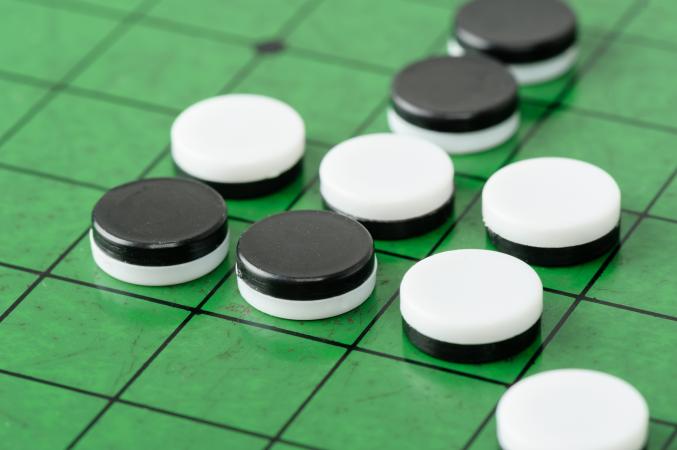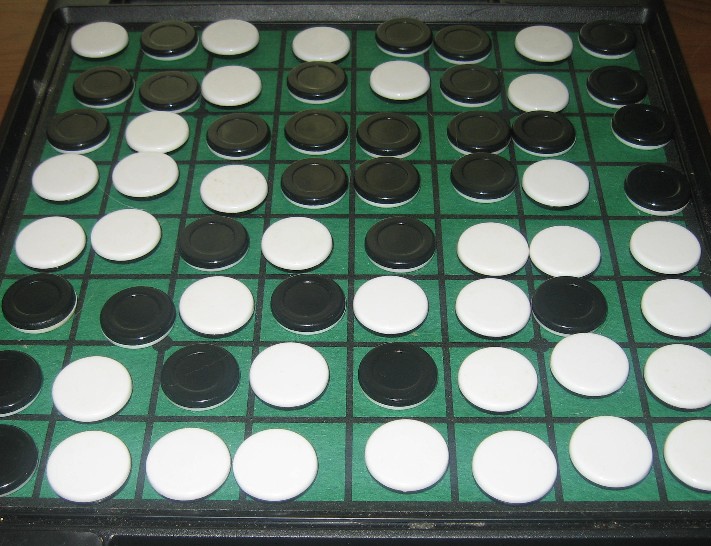Othello
Players: 2
Ages: 5 and up
Purchase: Buy on Amazon (affiliate link)
Math Ideas: Spatial reasoning, counting collections
Questions to Ask:
Which spaces can you play on this turn?
How many pieces do you need at the end of the game to win?
Which spaces in the game are the most important?
When playing a game with your child, should you let them win? This is a common dilemma for any parent who routinely plays games with their kids. On one hand, you don't want to beat your kid at Go Fish or Battleship or chess every time; they'd get sick of losing and quit playing with you eventually. On the other hand, you don't want your child to get so accustomed to winning that they can't handle a loss.
One reason I love Othello is that I don't have to worry about this balancing act. My son can beat me, even when I'm trying my hardest! It feels strange for me to lose a strategy game to someone in their Ninja Turtle pajamas, but the experience is more fun for both of us. As the box states, Othello takes a minute to learn and a lifetime to master.
I wrote about Othello in my 2017 Holiday Gift Guide, but I wanted to dive a bit deeper and share some of the interesting mathematical ideas in the game.
How to Play
Othello is played on an 8x8 board with a set of reversible discs that are black on one side, white on the other.
Four discs are placed on the center of the board, and each player takes turns placing a new disc on the board. The goal is to capture discs of the opposite color by placing your own discs on either side of them. To start the game, black can play in any of the squares marked with an x and then flip over the white disc that he has captured.
The game is exciting because momentum can swing wildly from player to player. The more black discs on the board, the more chances the white player has to flip a bunch of discs on a single turn.
Play continues until the board is full or neither player can place a new disc. Then the players count up their discs to see who won.
Below is a quick instructional video that further explains the rules.
Where's the Math?
The structure of Othello is ripe for your child to practice their spatial reasoning, one of my favorite topics in early math.
In particular, kids have to pay attention to the diagonal relationships between the discs. My son can easily spot a set of discs that have been captured vertically or horizontally, but he still struggles to see the diagonal captures reliably. Over time, as he becomes more attuned to those relationships, his strategic thinking will improve as well.
The end of the game, where both players count their pieces, is an opportunity for some wonderful conversations about counting.
Kids need lots of experience counting large collections of items, and many kindergarten and first grade classes spend time counting and recounting groups of objects. But it's hard, as a parent, to set a bunch of paper clips on the table and say "let's count these for fun!"
The benefit of counting in Othello is that your child actually wants to know the answer. After all, she has to figure out who won the game! While she counts, you could recommend some strategies for counting. For example, she could remove the pieces as she counts them, which ensures that she won't double-count any items. Then you could recommend that she organize her pieces in groups of five or ten, so that she can quickly check her work. As your child makes equal groups of ten, she is beginning to learn how the tens place works, and why it is so useful for keeping track of large groups.
Lastly, Othello is a fun mathematical toy that kids can play with even without playing the game itself. The reversible discs and the array of squares provide a lot of opportunities for mathematical art and play, which is just as developmentally meaningful for young children. If your kids are messing around with the pieces and not really playing the game, that's fine! They're still building their spatial reasoning skills in a less structured context.
Questions to Ask
I like to ask two types of questions during the game: strategy questions and counting questions.
If my son is pondering his next move, I might ask "which squares can you play on this turn?" If he points out a couple, I might ask him to find more. Then I'll ask "which square allows you to flip over the most discs?" By asking these questions, I am getting my son to explore more parts of the board on each move,as well as getting him to visualize multiple moves on each turn (By the way, I don't do this every turn. He'd kill me).
There is some deeper strategy to the game that involves the sides and corners of the board. If your child feels confident in the game, you could ask them which squares are the safest squares for their discs. Then you could both explore the underlying strategy.
Counting questions are great to sprinkle throughout the game. You can ask your child "How many discs did you just flip over? Who do you think is winning? How do you know?" At the end of the game, you can ask your child to estimate how many discs each player has on the board. Then you can check those estimates by counting all the discs.
I'll leave you with a puzzle for you to ponder with your kids: what is the largest number of discs that can be flipped over with a single move? Can you create a board that allows you to flip over that many pieces?
Click here to buy Othello on Amazon (affiliate link)





